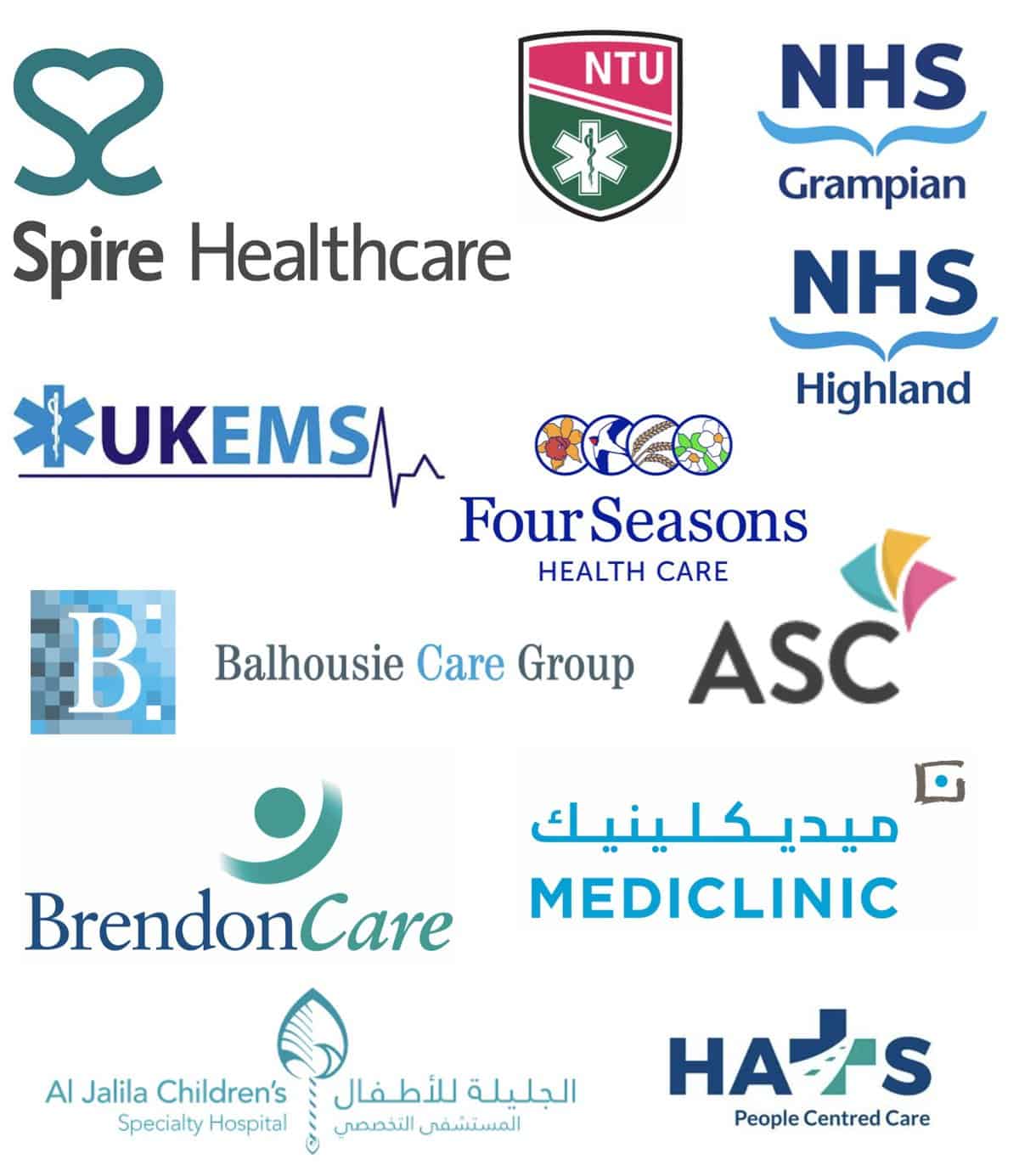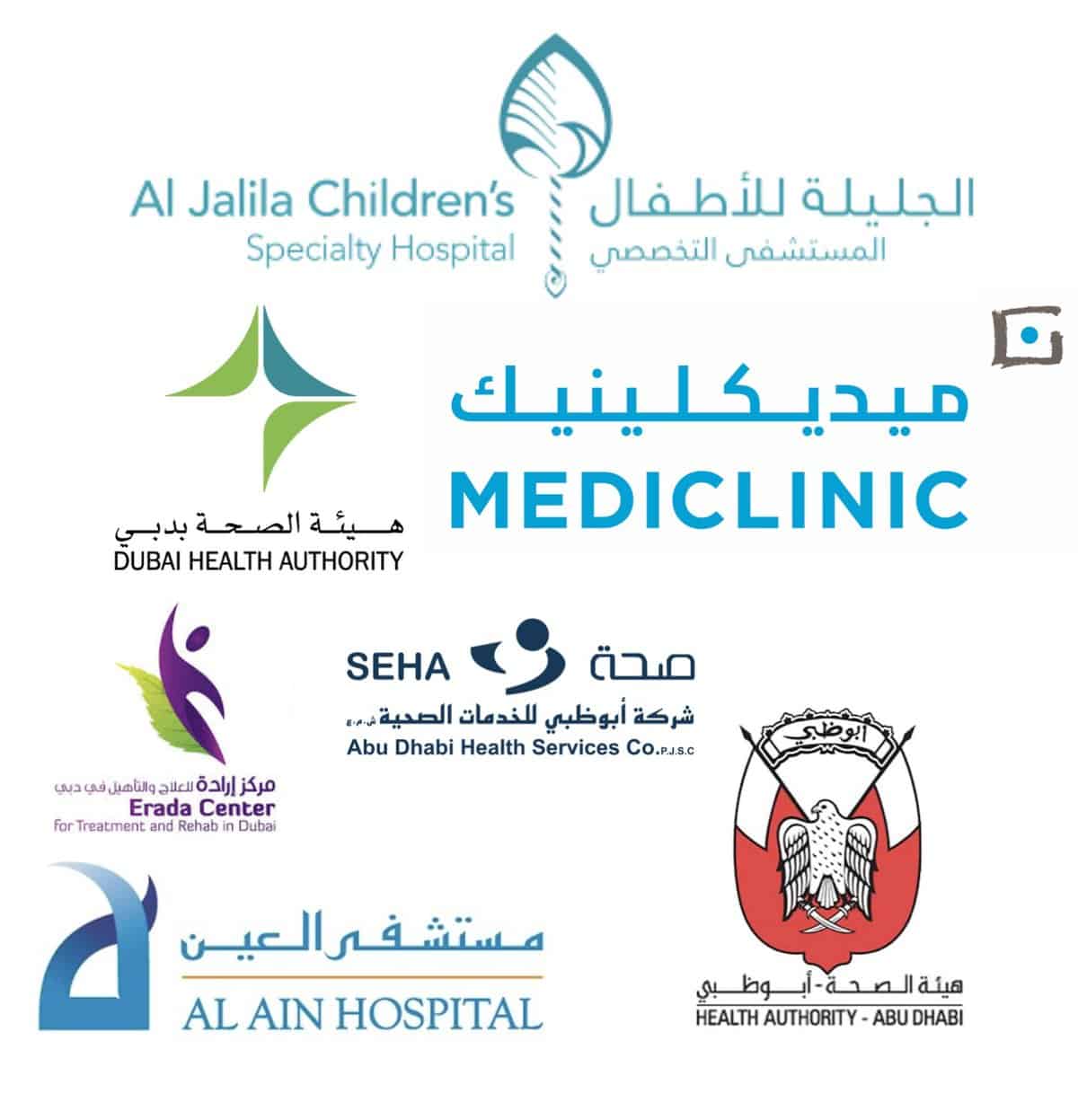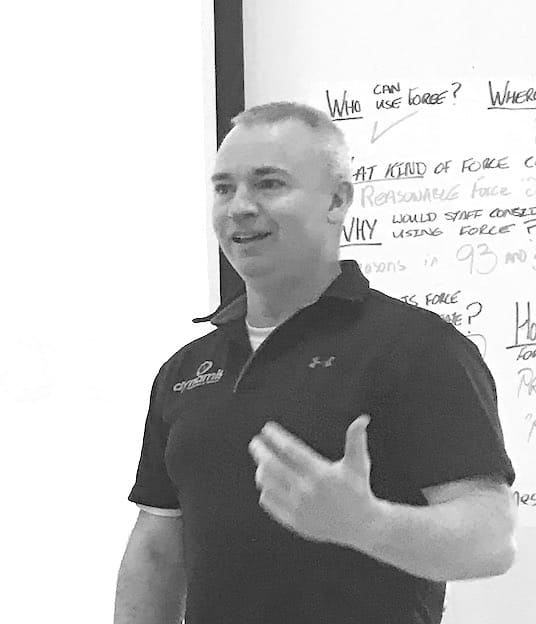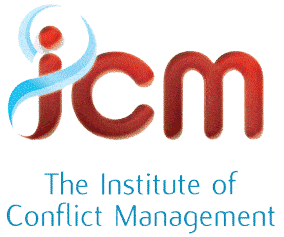
Let us help your team with Conflict Resolution
Conflict Resolution skills for NHS teams who meet upset and distressed - often vulnerable - people in their work.
As a healthcare security leader, you realize that conflict resolution in your hospital is a consistent issue:
Healthcare clinical and support staff seem to be coping but feel the pressure.
The hospital/trust is carrying health & safety and reputational risk.
Patients and Visitors are both vulnerable and presenting with abusive or distressed behaviour.
A training intervention seems to be the answer, but it MUST be effective...
At Dynamis we provide evidence-based and scenario-driven conflict resolution training through the whole spectrum of conflict, enabling staff with the skills and knowledge they need to professionally respond to any level of conflict.
Book your free Training Needs call now, to find the right training for your team.
conflict resolution clients...
Hospitals and Healthcare

Healthcare conflict management
Hospitals and Healthcare

Healthcare conflict management
conflict resolution training elements
Non-Escalation
Easing people's anxiety and not setting off conflict triggers, by being in emotional control of oneself and alert and decisive about how to Treat People Right. This is the ultimate test of Conflict Resolution.
De-Escalation
Tried and trusted pathways for expertly managing patients and visitors who are abusive, refusing or resistant to the reasonable requests of staff. This is Conflict Resolution at its most critical.
Crisis Intervention
Using empathy as a guide to create safety and to aid recovery for people who are in emotional distress or experiencing crisis. This is Conflict Resolution with vulnerable people.
Take Appropriate Action
Confident in the processes and procedures of your organisation, your team will make the appropriate decision about escalating their response or handing off to a team who can.
Your NHS staff can promote dignity and respect throughout your service.
Our wide range of courses are designed for public-facing teams who deal with vulnerable individuals and those capable of spontaneous aggression. Our aim is that every person is treated with dignity and is shown respect, even when there is disagreement.
Book a tailored training course from Dynamis Training and your team will:
NHS CRT Syllabus | Content | Detail of Course Content |
a) describe the common causes of conflict and identify the different stages of conflict | Conflict Triggers The Six 6Cs of Conflict | How to recognise the conflict triggers in ourselves and others, including the cues signal that a person has been triggered. The 6 Cs of conflict is a simplified version of the Kaplan-Wheeler analysis which offers a framework for understanding the process of arousal, mapping the stages of conflict. |
b) learn from their own experience of conflict situations to develop strategies to reduce the opportunity for conflict in the future | Conflict Primer Core Principle Empathy Trauma Responsiveness Social Contracts | Leverage the learners own experiences of conflict to discuss the results of poorly managed conflict, the causes of conflict and personal thoughts and feelings about how to best resolve conflict. The core principle in Conflict Resolution must be to Treat every person with Dignity by Showing them Respect, even when there is disagreement or discord. Empathy eases tension, and is the most versatile tool we can use to defuse conflict. We must: acknowledge their perspective, seek to understand what is driving them and anticipate their needs. Trauma Responsiveness means that we need to acknowledge the possible effects of past psychological, emotional and/or physical trauma that a person has experienced. A social contract is an agreement by all to treat each person with dignity by showing respect, consistently, with the goal of building respectful and safe environments. |
c) describe two forms of communication | Verbal / NonVerbal Talking/ Listening | Nonverbal Communication consists of the messages people send by how they present to the other person through their body posture, hand gestures, facial expression, tone, volume and pace of language. Verbal Communication consists of the word choice and structure of messaging used to convey meaning through the use of voice in an interaction. Listening is paying attention - “listening with all our senses” - to what the person is saying and trying to decipher the core meaning of their communication, not simply waiting for our turn to speak and telling the person what we want them to hear. |
d) indicate the level of emphasis that can be placed on verbal and non-verbal communication during a conflict situation | Be Alert and Decisive Threat Indicators | Learning to be situationally aware and ready to take action - a ‘preplanned and practiced response’ - if a threat is identified or a safety risk is presented. Threat indicators consist of proximity breaches, nonverbal cues such as pointing fingers or shaking fists, and verbal veiled or overt threat statements. |
e) understand the impact that cultural differences may have in relation to communication | Core Principle - 5 Approaches All People Proxemics | All people want to be treated with dignity and be shown respect in interactions with public-facing staff. Therefore the 5 approaches become important:
Some communication cultures are different - examples to be shown and discussed in class. |
f) identify the causes of communication break down and the importance of creating conditions for communication to succeed | Conflict Triggers Empathy - 5 Approaches Respond, Don’t React Showtime Mindset | The SCARF model describes an excellent short-hand for the key social influencer domains for human beings - Status, Certainty, Autonomy, Relatedness and Fairness. The 5 Approaches match to the SCARF model extremely well (see above). Rather than acting or speaking on first impulse, we must respond to events rather than reacting with our emotions to what is happening. First impulses are often driven by ego and can be disastrous in conflict. Learn to control own conflict triggers to maintain emotional equilibrium. The Showtime Mindset is a way of achieving emotional self-control and resetting to a place of emotional equilibirum so that we can respond to the interaction rather than being reactive. Leverage self-confidence and self-belief to project an appropriate level of professionalism into the encounter. |
g) utilise three communication models that would assist in dealing with different levels of conflict | Universal Greeting Persuasion Sequence Redirections Crisis Management | When we first encounter someone - often interrupting them in their day or task - it can be useful to have a habitual way of opening the interaction politely, professionally and giving it the best chance of proceeding without escalation. The Universal Greeting is about getting the interaction off on the right footing. The persuasion sequence is used to gain the other person’s voluntary cooperation when there is a rule or procedure laid down for them to follow in order to maintain an orderly, safe and secure transaction between the organisation and them. It offers staff a verbal process to follow when meeting resistance from the other person which offers dignity and respect. Redirections are tools used by staff to redirect negative behaviour such as abuse, intimidation or insults in such a way as to keep the interaction on-track for a positive outcome. A variety of redirection verbalisations exist to help staff to achieve their task while not getting ‘involved’ in verbal abuse. They also create opportunities for staff to decide if it is time to disengage if feeling unsafe. The Crisis Management Approach and the 5 Crisis Management tools offer staff a framework which can be used with any person exhibiting signs of short- or long-term cognitive difficulties. These tools help staff to work effectively with vulnerable people. |
h) recognise the behavioural pattern of individuals during conflict | The Six Cs of Conflict | Our ideal progress through Context, Contact and Closure may be derailed and complicated by Conflict, Crisis or Combat (See above for reference to Kaplan-Wheeler) |
i) recognise the warning and danger signals displayed by individuals during a conflict situation including the signs that may indicate the possibility of physical attack | Be Alert and Decisive Threat Indicators Take Appropriate Action | Learning to be situationally aware and ready to take action - a ‘preplanned and practiced response’ - if a threat is identified or a safety risk is presented. Where attempts at resolution or de-escalation may fail or be inappropriate OR where an immediate and clearly articulable safety violation or concern may occur, staff must take appropriate action. This may include calling for appropriate assistance, disengaging from the contact, or using self-protection methods to physically protect and escape from a situation if it has become a physical confrontation. |
j) identify the procedural and environmental factors affecting conflict situations and recognise their importance in decision making | Social Contract Gateway Behaviours Take Appropriate Action | A Social Contract exists when there is a clear understanding of what behaviours are inappropriate and there is consistent - albeit firm/gentle - intolerance by every contact person for such behaviours. So-called “Gateway behaviours” must be addressed to maintain the social contract and build respectful and safer environments. |
k) understand the importance of keeping a safe distance in conflict situations | Proxemics 10-5-2 | Distance affects the comfort level of people interacting with each other and their personal safety. At key distances (10feet - 5feet- 2feet), dynamis risk assessments can be made about safety and mood, presentation, behaviour and other intangibles, very quickly. Positioning, and hand gestures also influence safety and may enhance or detract from the quality of interaction. Poorly managed proxemics are the first step towards a person making the choice to assault a member of staff, and therefore warrant our attention and focus. |
l) summarise the methods and actions appropriate for particular conflict situations bearing in mind that no two situations are same | Treat with Dignity by Showing Respect Listen with all senses See the world through their eyes Ask and Explain Why Give Options Offer a Chance to Reconsider | Staff apply the core Dignity through Respect maxim at all times. Respect is shown through the 5 Approaches (described above in detail) and then use empathy to discover which of the available tools are best deployed within the interaction to reach the desired peaceful outcome. See the “Non-Escalation / De-Escalation Card” |
m) explain the use of ‘reasonable force’ as described in law and its limitations and requirements | Take Appropriate Action Dynamis ‘Principles of Reasonable Force’ | Reasonable Force is a concept in English Law which is governed by core principles. These principles can guide staff in the right responses to physical threats to their safety and include the concepts of Lawful Excuse, Necessity, Last Resort, Proportionality and Honestly Held Belief. Each concept has its own well-refined meaning in legal precedent. Although ‘it would be for a court to decide’ in any dispute, these principles when well-learned by staff can serve as excellent guides for decision-making and incident reporting frameworks. |
n) identify the range of support, both short and long-term, available to those affected by a violent incident | Trauma Responsiveness Empathy | Trauma may be acute, complex, historical or even secondary. Many people we meet will have experienced trauma and due to its essential nature and deep pathways in the brain, certain situations, contexts or behaviours may traumatise (or re-traumatise) people or trigger in them behaviours which they find completely unexpected. Peer support for our colleagues in the aftermath of an incident can be an extremely important healing opportunity for many. However, some of our colleagues may need more considered help and support, and it is important that in the aftermath of an incident that we carefully assess their need for this kind of in-depth care and support. “Are you okay?” is a hugely important question which we need to give appropriate care and attention to. Empathy: Acknowledge their perspective Seek to Understand Anticipate their needs |
o) understand the need to provide support to those directly affected by a violent incident and the wider organisational benefits of this. | Closure Peer Support Debriefing Supervisor Debrief as per NWAS policies Post-Incident Support as per NWAS policies Incident Reporting as per NWAS policies | Closure has the aim of ending an interaction with someone safely and on a positive note, which establishes a positive foundation for any future interactions and leaves them in a better state of mind than when we first encountered them. Closure as a concept also includes properly checking that the person we interacted with is emotionally, mentally and physically safe before we end our interaction with them, underlining the importance of handing over (for example, patients) after any high-stress encounter. A significant part of this module of the course will be built around the processes and procedures in place at NWAS for post-incident debriefing, post-incident in-depth- review, staff support, incident recording, reporting and additional support services available to staff which are built-in to NWAS operational doctrine. |
Our Process for Working with You
HI! I'M GERARD O'DEA
Director Of Training At Dynamis
Hi and thanks for visiting our website today.
In over 15 years of working with frontline staff who face difficult, distressed and dangerous behaviour, i have seen time and again how prepared staff can perform well and respond to challenging circumstances.
From teachers to nurses, teaching and care assistants to security officers in our hospitals and social workers in the community, if you deal with people every day, managing conflict becomes a necessity.
I became involved in this work because i saw the power of training and preparation in helping people to stay safe at work and to be more successful in working with their colleagues to create better outcomes.
I and my team of professional trainers now teach in over 200 training engagements every year around the uk and internationally for a wide variety of public-facing organizations just like yours.
We have sought out the best conflict management training content and the best learning methods in the world and bring them together for you and your team.


WHAT OUR CUSTOMERS ARE SAYING
Our Partners and Accreditation

MEMBER OF THE INSTITUTE OF
CONFLICT MANAGEMENT
Dynamis is a Quality Award Centre with the ICM, a recognised accrediting body in the U.K. for workplace training in the prevention and management of workplace violence.

EUROPEAN PARTNER FOR
Dynamis is the premier European Partner for Vistelar, a global consulting organisation covering training across the entire spectrum of human conflict.
REGIONAL REPRESENTATIVE FOR 9 ATTITUDES BEHAVIOURAL TACTICS
Dynamis represents the 9 Attitudes system, a fully behavioural approach to self-protection and physical control which is based on the observable realities of physical confrontation.
Our Courses and What they Cover
We tailor our Conflict Resolution courses to meet the needs of each organization or team that we meet, however our 4 main areas of work are as follows:
Join Over 3,000 Happy Customers
What our customers are saying:

Best Course I have attended in the NHS...
“This was by far the best course I’ve attended in the NHS. Fit for purpose, current, relevant and extremely well delivered. 10/10 for delivery, professionalism and structure.”
ANDY W. // Security Management Specialist

Serious improvements to how we deliver healthcare...
“I am proud to have watched 24 of our Healthcare staff grow in stature, confidence and experience in conflict management this week. We will roll out this training across our entire business to make serious improvements to how we deliver healthcare conflict management to the NHS.”
NICK SLATER, SOLUTIONS DIRECTOR // SERCO HEALTHCARE

Restraints halved...
“The amount of time we are spending in any restraints has been halved – and that is just data from the first four months since we started rolling out the training. It really opened even our eyes to the effectiveness of the approach. ‘If you visit the unit now, the first thing you would notice is the distinct lack of buzzers going off and attack alarms going off, because we hardly even hear them anymore.’”
Leanne - Deputy Manager, // ASC Living (Balhousie Healthcare)

"Gold Standard"
“I’d just like to take this opportunity to thank you for a first class course, both in delivery and content. The level of instruction was easy to follow, constructive and backed up by rationale, current best practice and legislation. This is definitely the ‘gold’ standard as far as I’m concerned and something as an organisation we need to aspire to."
Security Management Specialist, // South West Region
With over 15 years of experience working with clients, we are confident that we can gain an understanding of your issues, resources, timeframes and budget quickly and soon propose a training plan which fits your needs.
Dignity and Respect
We help contact professionals to manage difficult, distressed or dangerous people in their workplace in the most effective and professional way possible, to keep everyone safe, verbally if we can, and physically only if we must.
Our core value as a business is that everyone should be able to work and interact with services in the world while retaining their dignity and being treated with respect, even in circumstances which are difficult. We train your staff to create safety from chaos.
Our training calendar tends to book up some months in advance - there is no time like the present to begin getting your training organised and our client assistance team is standing by to help you!
Frequently Asked Questions
Usually the training venue will be our client's responsibility and full details of this are made clear around the time of booking so that you know what we are going to need to give your people the best possible experience of training with our team.
We have often helped our clients to source appropriate training venues, where that assistance was requested!
Due to the nature of our training approach, we often require a good-sized training room which has the capacity for your team to move around in and in which we can set up scenarios which are as close as we can get them to real-world applications of the material we teach your people.
Our training costs are often calculated on a per-day basis and directly related to the Needs Analysis which we carry out with you.
We are constantly working to make sure that the investment level is reasonable and competitive.
We generally ask for an investment which takes into account the type of content we are going to work on with your staff, the numbers of staff involved, the risk level of the encounters they engage in and the number of days of training which will be required to get your people up to the proper standard.
We are VAT registered and all pricing sent to you is 'plus VAT at the prevailing rate'.
We also charge travel expenses which you should discuss with our training advisor so that these are as clear as possible as you book in your training course.
Our training advisor is waiting to have a call with you to discuss your timelines and preferred schedule. We generally book training 4-6 weeks out from today, however we always have been able to respond to clients who need training 'as soon as possible' when urgent needs pop up. The sooner we talk with you, the sooner we can get the training in place!
There are numerous formats which we use to deliver training with your team, whether it be a large group or a smaller team. We know that the best group sizes for learning depend on the complexity of the material to be covered, the amount of time we have with your people and also the constraints you may be working with in your budget and resources. Most of our clients put 12-16 people in our less-physically demanding training courses, and often fewer people than this into our more demanding courses. Let's talk about the best solution for your needs....
Dynamis has attained the respected Quality Award Centre status (QAC #2201) with the Institute for Conflict Management (ICM), demonstrating our commitment to quality assurance and strict adherence to the most recent guidance on the management and prevention of workplace conflict. All our trainers are fully qualified and attend CPD development on a regular basis in accordance with ICM requirements.
Our goal is that you see a tremendous improvement in your team's ability to prevent and manage difficult encounters with the people in your service, so we focus on making sure that each training session with your people feels directly connected to their everyday work and is compliant with the relevant guidance which governs it.
100%
You are fully protected by our 100% Satisfaction-Guarantee. If you are not fully satisfied by the training we deliver for your team, just let us know and we'll send you a prompt refund.
Gerard O'Dea